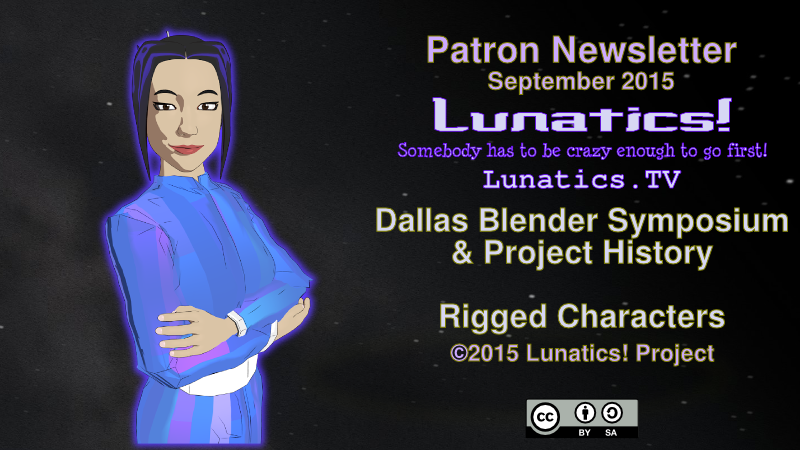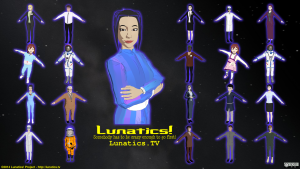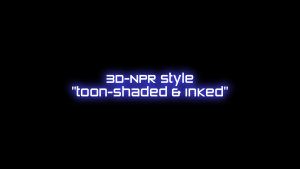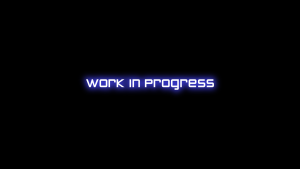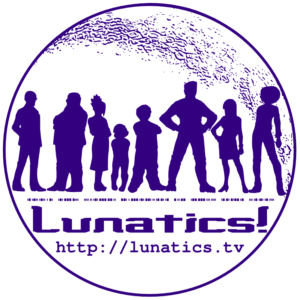This month we’ve been doing check-ins and reviews on work completed by the three CSU Interns we hosted over the Summer. And we’re getting things organized for Fall, including the assets we need for animation, and organizing publicity events. Producer/Director Terry Hancock and Writer Rosalyn Hunter attended the first annual “Dallas Blender 3D Symposium” and presented a brief “Introduction to the Lunatics! Project”. Although the original video from this talk was lost, we are including a slightly-revised version of the talk in this Newsletter, along with some explanatory notes. We’re also taking a look at our character development progress, including the 22 fully-rigged character models that have been completed so far.
Dallas Blender Symposium
It was fun to get out to a local Blender 3D event for a change. We’re not actually in Dallas, but it’s not a bad drive from our home where we (Terry Hancock and Rosalyn Hunter) work on the Lunatics! Project. There were perhaps a dozen people at the event, and more attended the livestream. Unfortunately, unspecified technical problems meant the video was lost, so we can’t simply refer you there for a copy of Terry’s presentation. Instead, he voiced over the slides to make the video we’ve included here. A few corrections or extensions were added, but otherwise this is the same talk.
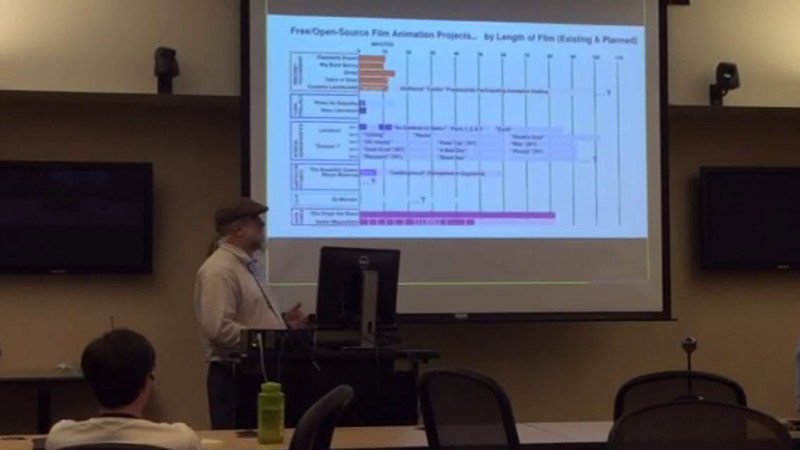
We didn’t know what to expect from this event, except that we were pretty sure few people would have heard of the Lunatics! Project, even though we’re based locally, and even though this is a fairly ambitious and large Free/Open Animation project. We really are very under-marketed. So Terry decided to present an introduction to the project with some metrics to compare it to other Free/Open Animation projects, as well as introducing the basic concepts of the series.
The talk was moderately well-received, although this is pretty clearly not our core audience.
Non-Photorealistic Rendering is kind of a stepchild in the Blender 3D community. Most enthusiasts get involved with Blender because of its capacity to make photorealistic renderings. And indeed it is very good for that. The talks preceding ours were mostly intermediate tutorials. One presentation from Eric Chaney showed how to use the motion-tracking tools to matte-in a video screen in live footage. Another presentation, by Kevin Mossey, demonstrated the use of procedural textures in Blender.
We wondered a bit whether this audience would have better appreciated the complex shading nodes needed to get our desired NPR shading. Perhaps if we do this event again, we’ll keep a more micro-focused, technical perspective, and present some aspect of the project as a tutorial.
Presentation: “Introduction to the Lunatics! Project”
“Introduction to the Lunatics! Project” (23-minute Presentation for the first annual Dallas Blender 3D Symposium). [NOTE 2025: this was a video prepared immediately after teh event, since we did not have video of the live presentation.]
Terry Hancock’s Additional Notes
- SLIDE 1 – Lunatics LOGO w/ silhouettes
-
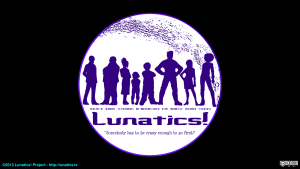
Medallion with Silhouettes Logo I’m guessing none of you had heard about Lunatics! project before this event (?)
So, I’m just going to try to tell you quickly what our project is. - SLIDE 2
-
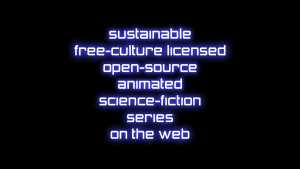
Slide with test: Sustainable Free-Culture Licensed Open-Source Animated Science-Fiction Series On the Web. Our goal is to create a
- SUSTAINABLE
- FREE-CULTURE
- OPEN-SOURCE
- ANIMATED
- SCIENCE-FICTION
- SERIES
- ON THE WEB
This is an incredibly ambitious goal. But we knew that going in.
To achieve it, we’d need tools, technniques, and methods that did not yet exist.
- SLIDE 3 – Lunatics LOGO w/ characters
-
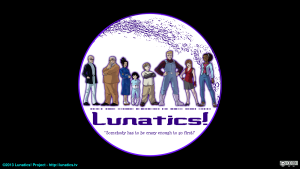
Medallion logo with full-color character lineup. We want to do these things “not because they are easy, but because they are hard.”This is, if you’ll pardon the expression, our “moonshot”.
What I mean by this is that, while the project is taking a lot of risks and using a
lot of untried ideas, it will, if successful, set powerful precedents for the future
development of free-culture, the arts, copyright policy, and low-budget animation.One of our goals is to set an example which others can follow. So in that sense,
the project is an experiment.So we went in “expecting the unexpected”, and the project has not disappointed us.
- SLIDE 4 – Collection of Artwork from the Project, still with characters
-
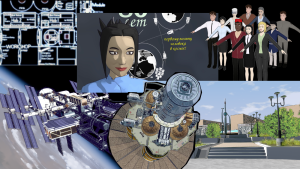
Collage of Production Artwork Lunatics is a story about the first permanent settlers on the Moon.It’s about the conflicts between exploring a place and actually living there.
And it’s about the obsessive, mission-driven personality of pioneers.
Which, plus the Moon, is where the title comes from.
- SLIDE 5 – Free Culture Comparisons – Pictures
-
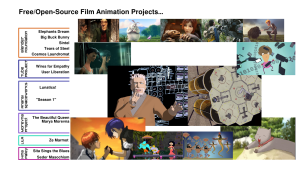
Identities of the Free-Culture film projects for comparison (i.e. who’s making them). Now, I want to show you where we fit into the “Universe of Free-Culture Animated Films”. These are the projects we regard (more or less) as peers.
Being Blender-folk, you probably know the Blender Foundation films.
You might also have heard of the Tube Project’s “Wires for Empathy”.
They also did a commissioned short film for the Free Software Foundation, called “User Liberation”.
Then, coming from the other direction, we have Nina Paley’s “Sita Sings the Blues” and her new project-in-progress, “Seder Masochism”.
“Ze Marmot” just had a successful Kickstarter this Summer.
And our closest ally is “Morevna Project”, who are making a cyber-punk anime fairytale, called “The Beautiful Queen Marya Morevna”. That’s led by Konstantin Dmitriev.
Our project shares various aspects with all of these other projects, and there is occasional sharing between us of ideas, technologies, and even occasionally people.
- SLIDE 6 – Free Culture Comparisons – Tools
-
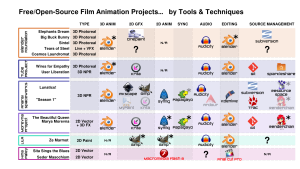
Software tools for Free Culture film projects. One way to compare projects is to look at the techniques and tools we use. This chart includes both 2D and 3D animation projects, and of course, one live-action project with VFX.
The Blender Foundation has stuck to photoreal rendering styles and VFX.
From the other side, Nina Paley’s work is vector-based 2D animation, done with Macromedia Flash 8, which is proprietary, and then I believe she uses Final Cut Pro to edit, also proprietary.
Morevna Project is also doing vector-based 2D, but using the free software Synfig package.
The style of animation in “Ze Marmot” is called “Digital Ink & Paint”, which they are doing with Gimp.
What we’re doing is “Non-Photorealistic” or “toon-shaded” 3D animation. Stylistically, this has a lot in common with the 2D animation projects, where 3D is used only for special effects — except we use it throughout.
A lot of different packages are used for making 2D art for textures, cels, or backgrounds.
We get a lot of use out of Inkscape and Gimp, and occasionally use MyPaint or Krita.Most of the projects use Blender’s VSE for video editing, although I’ve been using Kdenlive, which I find to be a lot more comfortable.
The faded icons are packages we’re considering, but getting little or no use out of currently.
Another thing to note is that the projects are often involved in improving the free software packages they use. That’s the primary purpose of the Blender Open Projects. Morevna is largely involved in improving Synfig, but they also re-packaged Papagayo, and wrote RenderChan.
We have not done much development, although if we do, it’ll likely be mostly on the project-management tools, as those are the weakest area for us.
- SLIDE 7 – Free Culture Comparisons – Lengths
-
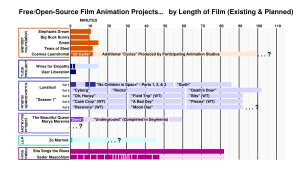
Comparison of planned project play length. Now, I want to give you some metrics to see how we compare to these other projects.
First of all – by goals. Here is the length of the planned animated projects, and also how much final animation has been realized.
These Blender Foundation projects of course, are finished. They’re all short films in the 10-15 minute range.
“Wires for Empathy” is also planned at about 15 minutes, and they’ve currently release some footage as previews, totally about 2 or 3 minutes.
“Sita Sings the Blues” is finished at 82 minutes. “Seder Masochism” will be of similar length andn structure, and is currently realized as a collection of clips animated to music, which will probably have a linking story added later.
Morevna Project’s “Underground” script will probably be about 60 minutes or so. That’s my own guess, based on having helped to edit the English version. They’re dividing it up into short segments for easier production and funding, and have completed one 7-minute “Demo” segment.
Morevna Project may move on to additional stories with the Morevna characters, if they can fund them, but they don’t have specific plans.
Our project looks REALLY ambitious on this chart. We have a series of staged goals. Our immediate goal is to release “Part 1” of our pilot story, “No Children in Space”. Then to release Parts 2 & 3. And then an additional episode, “Earth”, completing “Volume 1”, and then there are 4 more volumes in “Season 1”. This is all based on the assumption of raising more funding to make the project sustainable.
I’m very confident we will be finishing Part 1 this Fall, less confident about Parts 2 & 3, and hopeful about “Earth”. All of these have rough-edited soundtracks, and a lot of the assets have been modeled.
So far, we’ve released about 7 minutes of animation, cut into two previews and a title sequence. All of which I will show you in a few minutes.
- SLIDE 8 – Free Culture Comparisons – Histories
-
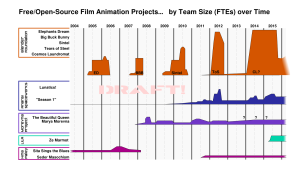
Estimated (very rough!) comparison of project participation sizes over time. Some are long sustained projects from small volunteer teams, some are rapid team projects. Another metric is to compare the size and history of the projects. This goes a long way to explaining the character of the projects.
This chart conveys the size of projects over time. The horizontal axis is time, expressed in years and months. Each project is indicated by a bar, with the height of the bar representing the number of “Full-Time Equivalents” of people working on the project during each month — so 1 person working full-time is one “FTE” and two people working half-time are also 1 FTE.
This is a “best guess” chart, based on project blogs and public announcements, as well as some educated guesses on my part, so you shouldn’t take the exact data too seriously. However, I’m
confident that the overall picture is correct.I omitted the Tube Project from this chart, because I was not able to find enough data on their
project contributors, and I know that it is complicated by student involvement, since Tube is
associated with a college computer graphics program.The Blender projects were all done on a fully-paid, sprint basis. They had a little bit of development; then brought on the Blender team of artists and developers; did a well-defined sprint; and then released.
Sintel went over-budget, got a boost in funds and size to get finished.
Tears of Steel was more controlled. And now they’re working on Gooseberry or “Cosmos Laundromat” which is complicated and huge and I’m not really qualified to talk about it.
On the other extreme, Nina Paley mostly animated on her own for years on “Sita Sings the Blues”, then had a little burst to get voices and a few custom music tracks, and then she did post-processing. She’s following the same pattern with “Seder Masochism”.
“Ze Marmot” is just new — there’s apparently three people working on it.
Both Morevna Project and Lunatics project have similar-looking profiles, with one or two people forming the core team, occasionally joined in spits and spurts by larger groups sprinting through certain goals. And in both cases, the team size is gradually growing, as we get closer to release.
- SLIDE 9 – Free Culture Comparisons – Budgets
-
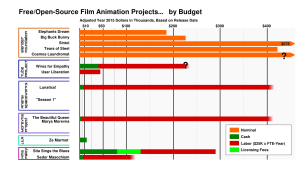
Budget comparisons, both as money and direct-contributed effort. Another metric is the relative film budgets.
The Blender Foundation movies have posted “nominal budgets” which are pretty good measures, because everyone on those projects were paid normally.
For the other projects, I’ve broken the budget into “CASH” investments and “LABOR” investments (what is sometimes called “sweat equity”). These projects have people working on them as volunteers, interns, or as an investment towards some cut of future profits (if any). This, I thinks for a much-more fair comparison.
I’ve used a very conservative number of $25,000 per full-time equivalent per year. That’s like working for $12.50/hour. So, that’s awfully cheap — so more realistic commercial billing would drive the labor budgets much higher.
So I hope these charts give you a rough idea of the relative size and character
of our project.And possibly you will see some of the unique challenges we’re concerned about!
- SLIDE 10 – Team Photos 2015
-
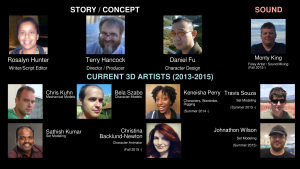
Current (2015) Project Team This is our team this year, with eleven people active on the project.
Of course, myself and my wife Rosalyn, who is the main writer.
Daniel Fu, who did our character design.
Chris Kuhn is responsible for most of our mech modeling.
Bela Szabo modeled the main characters, and refined the character style.
Sathish Kumar contributed to the sets for the pilot.
Keneisha Perry joined project, initially to work on additional characters and wardrobe. She’s moved into doing the character rigging, and is now involved in character animation. She’s also the first intern working on the project from California State University’s Media Internship Program.
In Spring 2015, we made formal arrangements with Calstate, and Travis Souza and Johnnie Wilson joined the project for the Summer. Travis and Keneisha are continuing this Fall.
Tina is not an intern, but has joined us to work on animation this Fall, and is also a Calstate graduate.
Finally, Monty King volunteered to help us with our foley sound and sound mixing, which are the final steps in creating the soundtrack.
- SLIDE 11 – Team Photos – Past
-
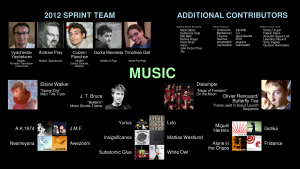
Past 2012-2014 Participants and Passive Contributors Of course, we’ve had other people work on the project in the past. They’re not active now, but their work is part of the project. This includes some past active contributors, as well as passive contributors — which is to say, people whose work was compatibly licensed so we could use it.
Most of the music falls into that category. We got most of it from Jamendo.
We did have some active help from Elaine Walker, who remixe one of her tracks for our main credits. And we got re-licensing permission on music from J. T. Bruce and Distemper.
- SLIDE 12 – Cast Photos
-
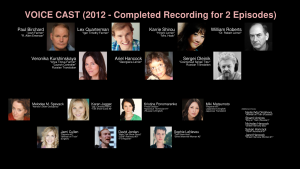
Voice Cast for ‘No Children in Space’ and ‘Earth’ This is the complete voice cast for “No Children in Space” and “Earth”. We finished recording all of the voices in 2012 — so we’re animating to a nearly-finished soundtrack.
- SLIDE 14 – Gantry
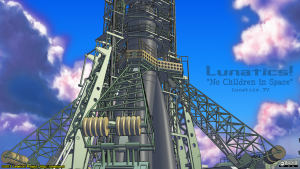
The idea behind this kind of style is that it encourages more audience participation, with the audience contributing some imagination to what they see.- SLIDE 15 – Launch Site
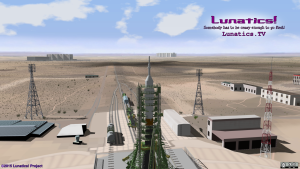
This helps to get over errors in animation, and allows us to use simpler models.- SLIDE 16 – Hiromi & Georgiana on train
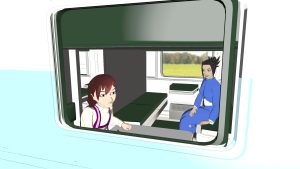
It also reduces the “uncanny valley” effect, giving us a little bit more tolerance for simpler character animation.- SLIDE 17 – Soyuz cabin
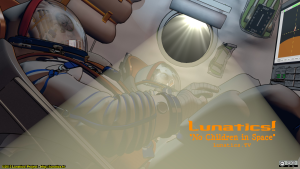
We have some optical effects, like reflections, combined with our toon style.- SLIDE 18 – Soyuz flight
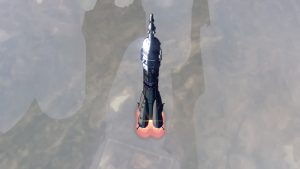
Here you can see some glare in the sunlight, but it still looks like a drawing.- SLIDE 19 – Staging
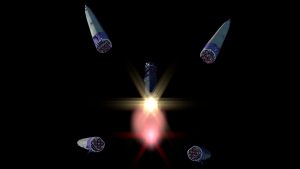
We’ve spent a lot of time trying to refine this style to get just the right mix of elements.- SLIDE 20 – Soyuz Orbiter
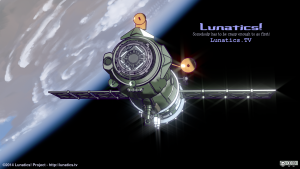
Keeping a project cheap is not alway appreciated, but I think it’s an underrated quality. When a production doesn’t cost so much, it doesn’t have to earn so much to be sustainable — and that means you don’t have to pander to a mass audience. Instead, you can focus on the core niche of people who really going to appreciate your story.- SLIDE 21 – Train Wheel
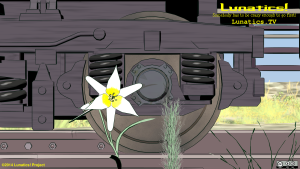
We do use textures, but we use them sparingly. The idea is to keep it simple and clean.- SLIDE 22 – Train Station Ext
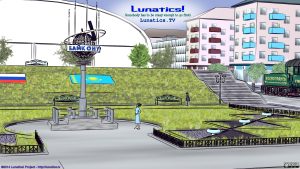
Sathish and I worked on these models of Baikonur Kazakhstan.- SLIDE 23 – GCS monument park
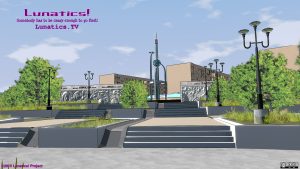
Also, cheap doesn’t mean shoddy. These models are less demanding than photoreal ones, but the effect of the NPR style is also striking and original. I’m now very happy with the look we’re getting, and I’m quite proud of how we’re making it look.- SLIDE 24 – Lander Interior
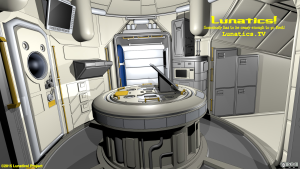
This lander interior is by Chris Kuhn.- SLIDE 25 – Rob speaking
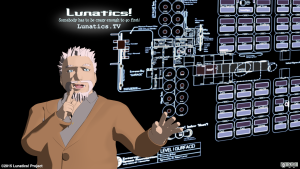
This is Bela’s latest model, which is Rob Lerner, the founder of the colony, giving his own presentation here!- SLIDE 26 – Space Station
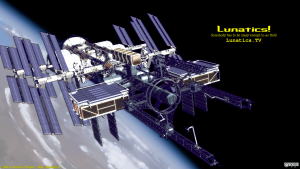
Chris Kuhn is a genius at mech modeling!- SLIDE 27 – Soyuz Int
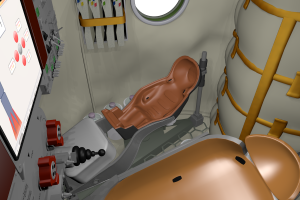
This is largely re-worked by Chris Kuhn, but the Soyuz interior was the subject of our sprint in 2012.- SLIDE 28 – Georgiana
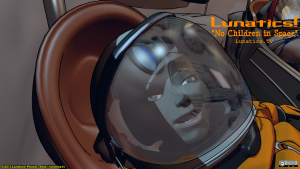
This is an earlier version of our character style which didn’t look as good. This was more of a “naive 3D” look than a “toon-shaded” look, and I’ve since learned a lot of ways to improve on this. So we’ll be replacing these shots with updated versions.- SLIDE 29 – Character Progression H & G
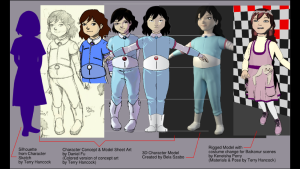
Overall, I think we’ve done a pretty good job of holding our character designs from concept, to design, to modeling, and finally shading.
- SLIDE 31 – Props 1
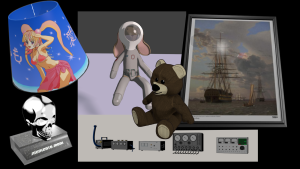
On props…- SLIDE 32 – Trains
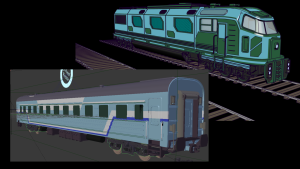
Vehicles…- SLIDE 33 – Cosmotrain
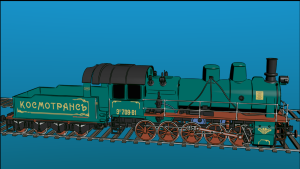
- SLIDE 34- Airplane
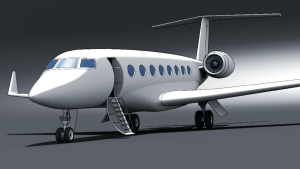
- SLIDE 35 – Bldg 254 Int
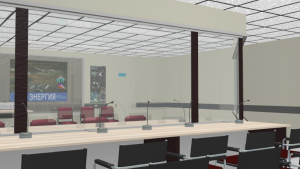
Sets…- SLIDE 36 – Mission Control
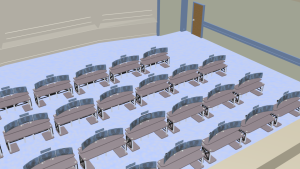
- SLIDE 37 – Covent Station
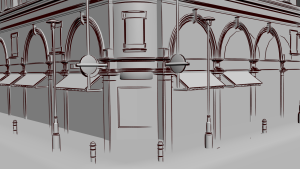
Some exotic…- SLIDE 38 – Dallas City Hall
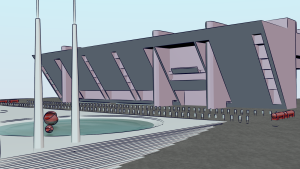
And some more familiar![NOTE: Dallas City Hall is across the street from the Central Dallas Library where this talk was given].- SLIDE 39 – Animation SC
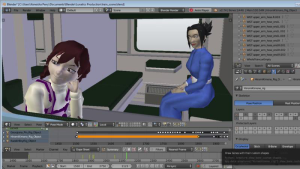 Right now, we’re working on streamlining everything in our animation process — rigs, scripts, action libraries, lip-sync tools, and so on — so that we can produce animation very quickly, allowing us to tell longer animated stories on a shoestring budget.
Right now, we’re working on streamlining everything in our animation process — rigs, scripts, action libraries, lip-sync tools, and so on — so that we can produce animation very quickly, allowing us to tell longer animated stories on a shoestring budget.
With luck, we’ll be finally releasing at least Part 1 before the end of this year.
[NOTE 2025: HA HA HA HA! LOL SOB.]At this point, I played the opening credits video.
- SLIDE 40 – Find us online
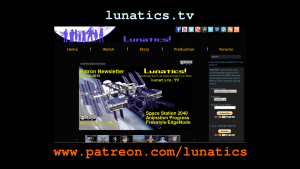
The URL to remember is just “lunatics.tv” — everything is linked from there. But we have pages on lots of social media, and we have a Patreon page. Right now we’re trying to get to our first $1000 per episode, mainly to cover costs — like rendering machines and web hosting.There’s also plenty of room for direct contribution on everything from modeling to animation and sound, to boot.
Characters Asset Review
22 Fully-Rigged Character Models Completed
Keneisha Perry has already started on principal animation, but with a statically-linked file, which is somewhat limiting, and which lacks some of the key time-saving elements we have planned for animation workflow. She’ll be moving her animation data into a new, properly-linked file shortly.
But for that, we need to make sure all of the characters we need are fully-rigged, with scripts and groups for character linking set up properly. This involves an Asset Review, which Terry Hancock has been working on for the last few week. As each character is completed, he mirrored the finished Blend file onto our Resource Space server:
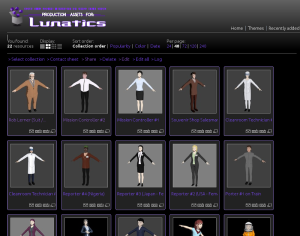

Here we have four costume changes for Georgiana, three for Hiromi, and two for Sergei — these are the “Principal” and “Secondary” characters for Part 1 of the Pilot (we don’t meet the other Principal characters until Part 2 or 3). We also have models for 9 (out of 12) “Walk-On” characters out of this sequence, as well as 2 “Extras”.
The designations are a four-tier scheme for character development that we’ve defined. The idea is to categorize how much effort we put into development based on how much is required to be seen on camera:
- Principals
- These are our main characters: Georgiana, Hiromi, Rob, Anya, Josh, Tim, Allen, and Sarah.
These characters will be in practically every episode. These characters need unique modeling and extremely versatile and complete rigging. - Secondaries
- These are recurring characters we’ll see again in future episodes, but not in every one.
Cosmonaut Pilot Sergei Titov falls into this catagory, as will the major characters at Iridium Base, and some characters back on Earth. These models don’t have to be a perfect match to the Principal models, but they do need to be pretty complete. - Walk-Ons
- These are characters that appear in just one scene, often delivering only a line or two of dialog, or in a few cases, silent. We can be a little lax on the rigging of these characters, as long as they have the facilities for the shots we need from them.
- Extras
- The lowest category of characters is for filling in crowd scenes or adding some life to the back or corner of a shot. We generally don’t ever focus on these characters, but simply need them for contrast and/or context. These characters generally don’t speak, and we might not even have a face rig for them if all they have to do is to walk, for example.
With this many characters, consistency is very important. All of our human characters have identical rigs, with the same bone names and drivers to control them. The responsibility for this has fallen almost entirely on Keneisha Perry, who has been able to do a fantastic job with rigging and weight-painting these characters. The body rigs are generated using Nathan Vegdahl’s “Rigify” script. The face rigs were created by Perry under Hancock’s direction, based loosely on the face rig in the “Sintel Lite” model, which is in turn based on the “Sintel” character from the eponymous Blender Open Movie.
To make things go a little more smoothly, we also have two Python scripts included in our rigging. One is generated by Vegdahl’s “Rigify”, while the other was adapted by Hancock to put facial animation controls on the ‘N’ panel in Blender’s 3D view.
Since the character rigs are identical between characters, it’s possible to copy poses and complete animation actions from one character model to another, which is one of the animation-reuse goals we have for Lunatics. So for example, compare the two models below of “Hiromi” and “Kazakh_Mom” from the train sequence. The Hiromi pose was copied to the other character, and then tweaked slightly to fit the mesh better:
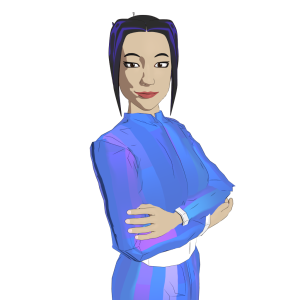 |
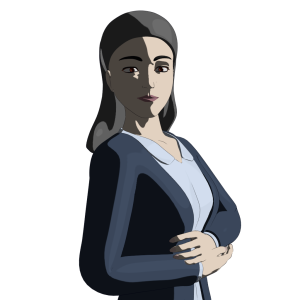 |
Poses can be copied from one character to another, as in this example, where Hiromi Lerner’s signature pose from the logo is copied onto the Walk-On “Kazakh Mom” character from the train sequence at the beginning of “No Children in Space”.
There are three more “Walk-On” characters, and about two-dozen “Extras” to be completed. The Extras, fortunately, can be mostly replicated with minor coloring changes. Unfortunately, Blender does not allow a single character to be instanced multiple times to create a “crowd” effect, so you have to copy the characters in the library file. There might be some ways around this, but for our project, we’re just going to copy and paste characters and make some tweaks for differentiation. Keneisha Perry created some shape keys so we can do some simple variations without a lot of effort.
Fortunately, principal animation doesn’t have to wait for all of these to be finished. Now that we have the main character models, we’re pretty much clear of that hurdle.
Other News
- Internships
- Two of our California State University Media Interns are working with us this Fall: Keneisha Perry and Travis Souza, continuing with the same work they were doing. We’ve also been joined by another recent Calstate Chico graduate, Cristina Backlund-Newton (“Tina”), who is not working as an intern, but is just building up her portfolio on this project.
- Publicity
- We’re looking into publicity events for this Fall, we have a possible exhibit space at a space industry event in the middle of October (the first annual New Worlds Initiative conference), based on a space-for-advertising trade with the organizers. But it’s contingent on them having enough space, so we’re not confirmed yet. If we do get to show there, it might be a great chance to meet potential corporate sponsors. Regrettably, simply paying for the exhibit space is not possible within our current budget. There’s also a local anime convention event in November and of course, the usual cycle of regional science-fiction conventions and independent film festivals. We’re planning to build an inexpensive, but nice-looking conference display for future exhibits like these. There will be quite a few opportunities once we have released even our “Part 1” mini-episode.
Until Next Month!
